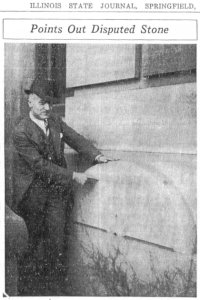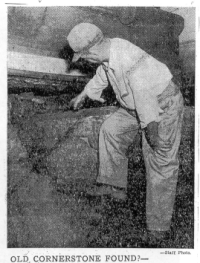|
Site Menu
Home
First Floor
Second Floor
Third Floor
House
Senate
Fourth Floor
Dome
Exterior Views
Postcards
Exterior Statuary
Basement, Etc.
Rumors
Trivia
Construction
Cornerstone
Past Capitols
The Kid Zone
|
|
Two Cornerstones
|
A couple of newspaper articles have yielded some new facts about the
history of the original cornerstone. Interestingly, the original
stone was discovered and re-buried long before June 1944.
From an article in the November 23, 1870
Illinois State Journal
Our readers will remember that the corner stone of the building was laid
last fall, with appropriate ceremonies by the Masonic Order. That stone
was obtained, we believe, from the Hamilton quarries, and was immense in
proportions; but it worked very poorly, and owing to the splits and cracks
which opened through it, it was found to be unworthy to be retained or
built upon. Accordingly, it was, a few days ago, removed from the wall
and buried in the ground in front of the corner and on yesterday a new
corner stone was placed in position. No ceremonies whatever took place on
the occasion, the only persons present being Col. Beveridge, one of the
Commissioners, the contractors, and a few curious citizens. The tin box
containing coins, papers, etc., which had been deposited with the former
stone, was securely placed in the new one, while various additional
contributions were made by those present.
The new corner stone is from the Joliet quarries and is very beautifully
chiseled. The panel, which is in relief, is the segment of a circle, with
the chord for the base. No inscription has yet been placed upon it, but
whether the Commissioners intend having this done, or to leave the matter
with the General Assembly, we are not advised.
From an
article in the December 5, 1885 Illinois State Journal
Some days
ago workmen employed on the east front, just where the northeast arch of
the old steps was taken down, dug down several feet in order to lay some
new foundation. While doing this they exposed a huge stone inscribed with
the name of the architect of the building, the old State House
Commissioners, the date of laying it, and various data. Everybody who saw
it concluded it was the corner stone of the State House, and many
speculations were indulged in as to what had originally been deposited in
it. It seems now that the facts are these, at least such is the story as
it now goes: This stone was brought on the ground for that use; but was
ultimately rejected and another one substituted in its place.
Accordingly, when the men were filling up the ground on the East front,
they found a conspicuous hole, so to speak, and, in order to fill it up,
they hitched a crane to the big block, dropped it into the hole and buried
it. If this story is true, the stone now exposed and supposed to be the
real cornerstone, is sufficiently explained and accounted for.
|
|
Accounts of the Placing of the Cornerstone
The
cornerstone for Illinois’ sixth capitol was formally laid on October 5,
1868, in front of the largest crowd ever assembled in Springfield to that
date. According to an article in The State Journal, October 8, 1936,
“people came from far and near, on railroads, in wagons and carriages, on
horseback and afoot, to witness the placing in the foundation of the chief
stone of the capitol building.” Evidently two bands were present and played
patriotic music for the crowds. An official procession was formed with
Captain J. S. Bradford acting as chief marshal. According to The State
Journal, in the stone was placed a large metal box in which were
deposited official documents of the nation and state from the Virginia
Charter to that date, photographs of distinguished men of the day, samples
of industries of the state, a bottle of whiskey from P. L. Howlett’s Riverton
distillery, and an Elgin watch.
The
cornerstone is described as being eight feet long, four feet high and three
feet wide and was laid by the Masonic fraternity. Grand Mater Jerome R
Gorin officiated the ceremony. The Lelands (of the Leland Hotel) hosted an
“elaborate banquet” after the ceremony. One person present at the feast
stated, “never before in my life had I seen so much and so many good things
to eat, and my eyes have not seen the like of it since.” |
|

January 10, 1937
Photo:
Paul M. Angle, head of the State
Historical Library, is shown pointing to the much-disputed, long-lost
cornerstone of the state capitol building. The stone to which Angle is
pointing is located near the bottom of the steps leading up to the north end
of the east entrance to the building. The original is buried nearby.
It had to be taken out and a new one substituted when it cracked. |
Missing?
Of course it took a number of years, approximately 20,
to complete the construction of the statehouse. The original cornerstone
was laid directly under the east window of the former private office of the
governor. According to The State Journal, once Superintendent John C.
Cochran got around to construction of the east wall of the building, the
cornerstone had been cracked and was badly deteriorated. The stone was then
removed and replaced by a plain stone, identified only by a raised
semicircle as if it was prepared for engraving, which was never done. Did
the nondescript new stone now contain the relics that were placed in the lost stone?
Where was the original cornerstone placed? Was it destroyed? Rumors were
that it was buried somewhere on the grounds possibly because the name of
former Attorney General Robert Ingersoll, a rumored atheist, was inscribed
on the stone.
|
|
Found
In June of 1944 while replacing the
steps on the north approach of the east front of the building workers found
the original cornerstone. Evidently the stone had been buried under the
steps for over seven decades. The stone was inspected and no contents were
found inside. The question of where the contents were only adds to the
strange happenings related to the cornerstone. The stone is now located on
the northeast front corner of the building just feet away from its original
location.
Photo to the right:
What is
believed to be the long missing first cornerstone of the present state
capitol is pictured a short time after it was unearthed yesterday by
excavators engaged in remodeling work on the capitol front. Shown pointing
to the ancient stone (it is dated 1867) is Roy Tanner, one of the men
employed on the construction project.
The old stone was found beneath the east steps. |
 |
|
Contents Not Found for Over 20 Years
As
stated above the contents of the cornerstone were not found for
approximately 20 years after the discovery of the original stone. According
to an article on the contents of the stone, “The Day We Found Lincoln’s
Whiskey Bottle, by Wayne C. Temple, when workers were searching for the
original plans of the capitol in 1966, it was suggested by experts that the
capsule may have been located in the 2nd unmarked cornerstone.
Upon receiving approval from Secretary of State Paul Powell, the cornerstone
was opened and the box removed. What was found in the box is very
interesting. Among items lying in the box was a unique bottle with the
words “This whiskey was made for Abraham Lincoln, Sept. 20th 1860
and presented to him as an Emblem of his Administration, it is Pure, & will
grow Better, as it grows older. P. L. Howlett.” (Temple, p. 15) What
remains a mystery is whether Lincoln actually ever possessed the bottle. By
the way, the plans were not found in the box and no copy has ever been
found. |
|
1988
Time Capsule
On
July 2, 1988, Secretary of State Jim Edgar officiated the
entombment of a time capsule commemorating the 100th anniversary
of the completion of the Statehouse. The plaque over the capsule can be
found just north of the original cornerstone at the northeast front of the
building.
|
 |
The photo on the left shows the original cornerstone
displayed on the northeast side of the capitol. The picture on the
right is of the current cornerstone, just to the south of the old one.
Plainly visible is the block cut out to remove the contents. |
 |
|

